DIAMOND/BOSWORTH INTERSECTION UPDATE
First up was Britt Tanner, senior engineer with the Sustainable Streets program of SFMTA. She came to speak about the recent Diamond and Bosworth signal update. “I’m going to try and stay clear of history,” she said lightheartedly – and preemptively.
Changes to the troubled intersection began in 2015 and are focused on reducing congestion and enhancing pedestrian safety. First the sidewalks were widened. That was followed by a westbound left turn arrow, then a northbound left turn arrow, and then changing the timing of lights on Bosworth; all aimed at relieving the choke points caused by shuttle buses, ridesharing services, and the usual traffic entering the freeway or headed toward BART.
Many of the changes have been criticized for not solving the problems or, indeed, for making them worse. Tanner explained, without trying to be too technical, how the decision matrix works in the traffic engineering world. For example, an option that is rated 1.68 means that 68 cars are still waiting to get through the intersection when the light turns red. The dumbed down version of this statistic is a mad face. The matrix illustrates that there’s no one good solution, but there is one that’s the least bad.
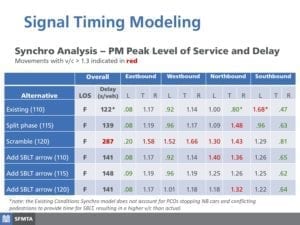
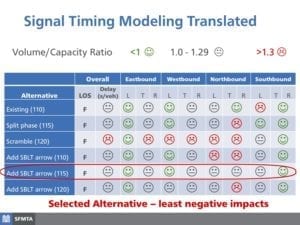
Many people were interested in the concept of the pedestrian scramble. That’s a pattern in which all traffic stops at one time, allowing all pedestrians to cross in all directions. This causes traffic to back up even more, which might be worth the sacrifice for pedestrian safety.
However, although counterintuitive, Tanner says this is not actually safer for pedestrians. It would cause too many people to crowd the sidewalks at peak times; people could spill over into the street; and if, because of the crowding, they were unable to cross before the cars were again signaled to proceed, they might try to cross anyway.
Tanner gave her sober conclusions: “The situation is failing and it’s always going to be failing.” And “The turnip isn’t growing any bigger.” (Might be a mixed metaphor there but possibly this means there’s just not enough space at the Diamond/Bosworth intersection.) She took notes on the concerns and suggestions that were raised and told the group she’d make sure they got consideration at SFMTA.
KERN ALLEY SITUATION
Patty Hayes, whose mother is the owner of the parking lot property on Kern alley, explained their short- and long-term plans for the property. (The property across the street from the lot is owned privately by someone else.)
The parcel is zoned for both commercial and housing. It’s been an informal parking lot for many years, but it’s been in dire condition, to the consternation of many in Glen Park.
The Hayes family intends to develop the property but is not yet ready. In the meantime, they would like to make it into an improved, paid parking lot of 19-22 spaces. There was no precedent for this, and there was also opposition by people who opposed a permanent parking lot on the site.
Jeff Sheehy, in one of his last acts as District Supervisor, pushed through legislation allowing for an improved lot for six years, after which presumably there would be concrete plans for final development of the property.
SF-Arc, a Glen Park architectural firm, is working on the design of the parking lot, in consultation with the planning department.
FIX-IT TEAM PROGRESS REPORT

Sandra Zuniga, of the mayor’s office Fix-It Team, coordinates the work of seven city agencies that focus on improving the cleanliness and safety of the city’s neighborhoods. Along with dedicated volunteers, they’ve been working on projects in Glen Park for the past year or so. As part of the program, we now have two Street Ambassadors who keep the commercial area clean and maintain the planters. The BART flower stall has been repainted. The Greenway, a major multi-year undertaking, got help with clearing and clean up events. Most recently, the Arlington Street open space has gotten intensive care by the community and the Fix-It Team.
In one of London Breed’s first acts as mayor, she signaled her commitment to carry on this important work by allocating an additional $750,000 to the Fix-It Team. Among the projects that will be undertaken will be to employ homeless people to help clean up the Mission district.
BART DIRECTOR BEVAN DUFTY
Director Dufty, at one time our District 8 Supervisor, reported on many things BART: the ugly, the bad, and the good. 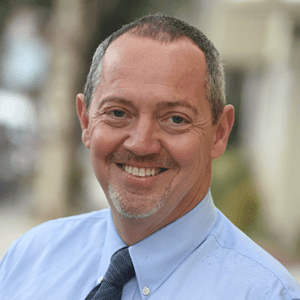
“This has been a brutal week,” is how Dufty started off, the worst event being the stabbing murder of Nia Wilson at the MacArthur BART station.
Then there is the continuing crisis of active drug use, homeless people hanging out and defiling the stations, and commuters feeling threatened. Dufty spoke with police chief Scott, telling him that things are getting worse, not better. In a move which Dufty admitted was clearly grandstanding to get attention, he recently set up a table at the Civic Center station, and along with the Salvation Army and the Homeless Outreach Team, they sought to address the situation head on.
It might have been a turning point, as things have improved somewhat, with a long way to go. The long-term solutions involve more shelter beds and access to drug treatment. The city needs to take more responsibility, said Dufty.
As to physical upgrades, because of delays, only 20 out of 180 new trains have been delivered.
On the good side, riders can download the BART Watch – Police app, on which they can quickly, discreetly and anonymously report suspicious activity directly to BART Police, who will respond on the train. It’s available on iOS or Android. (Note: not to be confused with another app, BART watch – Station Times)
Twenty-one janitorial positions have been filled, and elevator attendants at the Powell and Civic Center stations escort 1200 people in wheelchairs daily.
Locally, Dufty talked about the possibility of creating a community garden on Wilder Street, in the BART property behind the station. There is a fenced-off structure housing the ventilation system, meant to be used for unexpected events in the BART station. The land around it has the potential for around 25 plots of 4’ by 4’. Canyon Market’s Janet and Richard Tarlov are spearheading the effort, which needs to overcome hurdles of insurance, fiscal sponsorship, and secure fencing, to name a few.
Many people have complained about the barren planters inside the station. That’s complicated too. Plants need to be maintained and a BART employee would be needed for the task since the planters are above the tracks. The location poses dangers and would require the use of cherry pickers. Whatever goes in that space must require little maintenance. The group had some fun throwing out artistic solutions. Funds are being set aside for conserving existing art in BART stations.
SUPERVISOR RAFAEL MANDELMAN
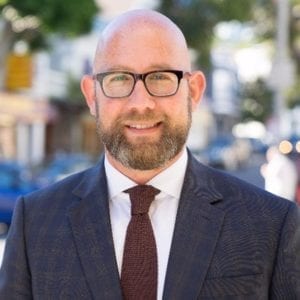
Mandelman received a warm welcome on his first appearance at a GPA meeting since his election as District 8 Supervisor. “The mayor and I share a strong commitment to help folks with mental health and drug addiction have alternatives to living on the street, and access to treatment on demand,” he said.
His top concerns are interrelated: homelessness, encampments, “scary people,” dirty streets, unsafe public spaces, and lack of affordable housing.
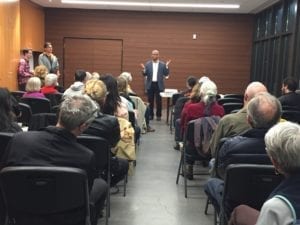
In a give and take, people told Mandelman of their concerns in Glen Park. Among them:
Removal of trees unnecessarily and aggressive pruning – Mandelman noted the tremendous backlog of tree maintenance since SFPW took back responsibility. There aren’t enough arborists and it will take five years to cycle through the entire system of trees.
Commute traffic congestion, drivers running stop signs, lack of enforcement – Mandelman is on the Public Safety and Neighborhood Services Committee, so he will be deeply involved in these issues. SFPD had over 100 officers on bikes and now there are only 38 0r 39 for the entire city (although there’s still plenty of ticketing, he observed). New classes in the police academy will increase staffing overall in the future, however. There are more violations due to ride sharing services with inexperienced drivers.
There’s a lot of consternation about the possible locations of Go Bike stations in the Arlington/Miguel area.
Mandelman will be tracking all of the concerns raised by his constituents and his goal is to answer all emails within 24 hours. Write to rafael.mandelman@sfgov.org.